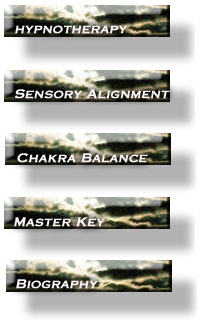

|
|
|
|
|
|
|
|
|
|
|
|
|
|
|
|
email us for a free sample session

Our sensory room includes a simultaneous experience of light, sound, and motion. It creates a resource state where the power of the mind enhances sensory messages.
The light is oscillating colors using magneta, rub, red-orange, yellow-green, blue-green, and blue-violet. The colors cycle from bright to dim to bright again.
The sound is modulating sound that cycles from weak to moderate loudness throughout the session.
The motion is a table cycling eleven times a minute in rhythm with the body's relaxed state.
The use of colored light is based on the 60-year old science of Syntonic Optometry, and still the meaning of the power of light is barely tapped. Dr. Harry Riley Spitler developed an entire system of watching specific colored light to augment the function of the nervous and the endocrine systems and put the body in balance. When light enters the eye, besides going to the visual centers, it goes to the pineal and hypothalamus in the brain. These are the brain's master regulators, collectors, and senders of information for the body. They tell everything that is happening outside and inside. The pineal sends information to every single place in the body. These light signals are color-specific to mental, emotional, and physical functions in our body to keep us well and in balance. Magenta (balancing), Ruby (survival, stability), Red-orange (creativity, spontaneity, self-esteem, passion), Yellow-green (power, love,) Blue-green (love, expression), blue-violet (conceptual, intuitive thinking).
Reference: Light Years Ahead, Brian J. Breiling, Psy.D.
Being able to hear well is vital, but there is another aspect to sound. Not only do you need to hear well, but the information you hear needs to be encoded and transmittted as information to the brain. If you are hard of hearing, you receive diminished information. Even if you hear well, if the information is not encoded properly, is distorted, you receive garbled information. Millions of people wear glasses, indicating a vision problem. But hearing problems most often go unrecognized. A major cause of garbled information transmission can be abnormal sensitivity or insensitivity to certain sound frequencies. Yes, hearing a sound level too well or not well enough in relation to other sounds of identical intensity can manifest as behavior and learning problems. Modulated sound re-educates the abnormal listening sensitivity or insensitivity. Retraining the ear of someone with these problems helps access much more intellectual and emotional capacity.
Reference: Hearing Equals Behavior, Guy Berard, M.D.
The inner ear vestibular system has many interconnections with almost every other part of the brain. Motion affects the vestibular, which is the sensory system that responds to the position of the head in relation to gravity and movement. The messages received through the nervous system act as a gyroscope and help with posture, balance, and movement. These electrical impulses also produce learning and behavior. Organized sensory-motor patterns of the brain produce organized learning. If the brain cannot perceive the messages correctly, learning problems develop. One is unaware of vestibular function until it is overstimulated by motion and motion sickness ensues. An underactive vestibular system contributes to hyperactivity and distractibility. Learning and behavior are ways of telling how effectively sensory information is being received and processed. Vestibular stimulation through motion is used to either quiet, stimulate, or organize a child's or adult's activity level.
Reference: Sensory Integration and the Child, A. Jean Ayres, PhD